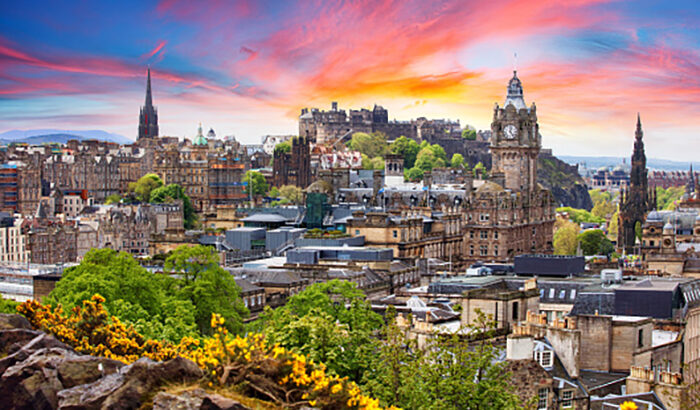Edinburgh: A New History,
by Alistair Moffat
(Birlinn, £14.99 / €18.00)
Edinburgh: The autobiography,
edited by Alan Taylor
(Birlinn, £20.00 / €24.00)
I am always astonished when Dubliners extol the graces of Georgian Dublin, thinking to myself that they can never have seen Edinburgh to make such a statement. Undoubtedly the New Town of Edinburgh is the premier Georgian city in these islands, but that is the least of the city’s virtues.
In Victorian days people often called Dublin the “second city of the Empire”. This was merely bluster, for clearly the city of John Knox, Mary Queen of Scots, David Hume and Adam Smith really filled that role for several recent centuries. Yet it is a city of which Irish people – bar the occasional trip to see the rugby at Murrayfield – know little of and care less. This is a great shame.
Of late Edinburgh has been celebrating its 900th year as a city, and these two very different books have been published in Edinburgh to mark the event.
Alistair Moffat is the former director of the Edinburgh Festival Fringe, only one among his many accomplishments, among them some six books dealing with various aspects of Highland and Scottish history.
Adroitly
The present history is a short text, barely two hundred pages long. But the material is handled so adroitly and so confidently, that one hardly notices, for it nevertheless provides an essential history of Scotland’s capital, rather like a bowl of strong Scotch broth.
He has to admit at the very beginning that though the city may be formally nine hundred years old, the place has been a human settlement of some kind for seven thousand years.
But he avoids burying readers in prehistory, and his fifty short chapters concentrate on what people will really want to know, on what makes the Edinburgh of today what it is.
To outsiders it can be a bit of a mystery. Years ago, on a brief stay in the city, where I was contributing to a BBC Scotland documentary about Arthur Conan Doyle, we visited the National Gallery of Scotland. There we were perplexed by an exhibition devoted to “44 Scotland Street”.
One of the curators attempted to enlighten us about the delights of Alexander McCall Smith’s saga, then running as a perennial serial in The Scotsman. That was long ago. Today there is hardly anyone who reads English at all who does not know and enjoy the doings of the denizens at that address and their friends and associates.
This book is dedicated to McCall Smith, which is appropriate. But it also contains far, far more. But the focus of these pages is on the city, and those who created its special characters, and they, as often as not, are not the great and good, but the striking, exceptional individuals who have given Edinburgh its character.
Great events are not ignored. In a mere two pages he gives the readers all they will really need to know about “The Great Disruption”, the schism in the Presbyterian Church of Scotland that saw the emergence of the “Wee Frees” – the adherents of the Free Church of Scotland in the 1840s.
He deals too, in the same essential manner, with John Knox and Queen Mary; their angry exchanges belong to history. But religious prejudice has a long life in Edinburgh, even the sophisticated city of the Festival Fringe. On one visit to the city my wife and I heard Mass in St Andrew’s Church, in the west end, to which we were directed by the receptionist at our hotel.
Moffat deals succinctly with the long lasting anti-Catholic prejudges of some in the city, the Protestant Action Society, councillors from which gained 31% of the vote in the 1930s”
This turned out to be a chapel that had to be built on part of a private garden, as the City authorities would not grant permission for it to be built elsewhere. The chapel was a plain edifice of red brick and stained wood; but the parishioners were most welcoming, even to two strangers from Ireland.
The history of the chapel and the prejudices that surrounded it seemed out of the ordinary. But in the three pages of a chapter entitled ‘Ugly Edinburgh’, Moffat deals succinctly with the long lasting anti-Catholic prejudges of some in the city, the Protestant Action Society, councillors from which gained 31% of the vote in the 1930s.
Reaction
This was a reaction to holding of a Eucharistic Congress the city in 1935, when there were ugly riots, and those attending the Congress were stoned in Canaan Lane. The movement’s founder, John McCormack, was re-elected until 1963, and used to drive around the city in a van painted with the slogan ‘No Popery’.
The same group clashed too with the British Union of Fascists, as Mosley’s party supported an end to partition in Ireland: politics makes for strange bedfellows at times. “Back in 1923,” Moffat notes too, “a pamphlet entitled The Menace of the Irish Race to our Scottish Nationality was widely circulated”. The Irish were, it was claimed, “drunken, promiscuous, uncivilised and carried deadly diseases” – typhus was then called ‘Irish Fever‘.
Casual visitors may not be aware of any of this when they ramble among those souvenir shops on the Royal Mile and buy their tins of Haggis.
In almost the final chapter Moffat notes that in 1957 the Church of Scotland had 1,320,000 members – 27% of the total population of Scotland. By 2022 the membership numbers had collapsed to 283,600, the vast majority of whom never attended any kirk.
But such stuff now seems like a dead letter. Moffat ends on quite a different note, with a tribute from McCall Smith, to the city of fiction, romantic Edinburgh, the city of Miss Jean Brodie and Ian Rankin, “the most beautiful city in the world”.
Anthology
The last title in the list of books that Moffat gives for “Further Reading” is Alan Taylor’s Edinburgh: The Autobiography. This is a massive anthology running to nearly 350 pages, in which every character of the city worth knowing about, finds a place with a representative extract. As a companion volume to Moffat, it is immensely enjoyable. In it the city speaks for itself.
But be advised. There is nothing here about long established satires on Scotland of Sandy the ubiquitous penny-pinching Scotsman, who was for so long a feature of the pages of Punch in its heyday, a companion piece to Ireland‘s landlord shooting Pat.
There is no allusion in either book to the satiric thrusts of Thomas Love Peacock in his 1831 novel Crotchet Castle at the ‘Athens of the North, and the Scottish economists of the day with their sweeping financial and social theories, and their love of ‘paper money‘, voiced by his character Mr Mac Quedy in debate with the classicist English cleric Dr Folliott.
The Scots, it seems, can laugh at themselves, but fail to see the funny side of those south of the Tweed who laugh at them. But then, that is a failing of us all.


 Peter Costello
Peter Costello The changing moods of Ediburgh large
The changing moods of Ediburgh large 